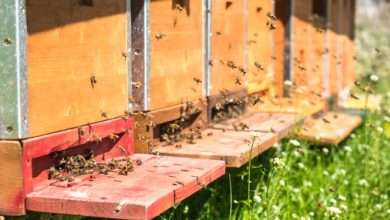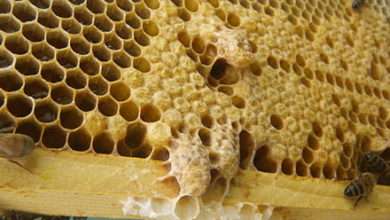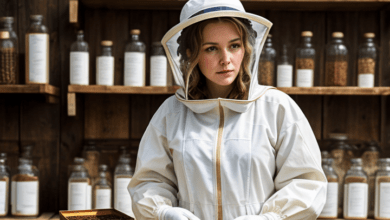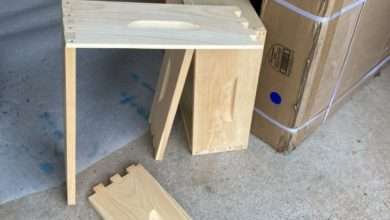What is a Dearth Period in Beekeeping?

Beekeeping can be an incredibly rewarding activity, with a variety of intricacies that create an elegant and delicate balance within a colony. Every move a beekeeper makes requires careful planning and consideration for the untold thousands of tiny workers under their care. One important factor that every beekeeper needs to consider is what is known as the dearth period.
This article will discuss what a dearth period is, why it is important, and how beekeepers can best manage the process through careful monitoring and risk management.
Understanding Dearth Periods
A. Definition and Characteristics:
Dearth periods, also known as dearth seasons, refer to periods of time within the beekeeping calendar when nectar and pollen resources become limited or unavailable. During these times, honeybees face difficulties in finding adequate food sources, which can have severe consequences for the survivability of the colony.
Dearth periods are typically characterized by a noticeable decrease in honey production, reduced brood rearing, and increased vulnerability to pests and diseases.
B. Factors Contributing to Dearth Periods:
- Seasonal Changes and Weather Conditions:
One of the key factors contributing to dearth periods in beekeeping is the natural cycle of seasonal changes and weather conditions. Different regions experience varying climates and temperatures throughout the year, which directly affects the availability of nectar and pollen.
For instance, during the winter season, most regions experience dearth periods as plants go dormant and produce little to no flowering. Similarly, excessively hot or dry summer months can also lead to reduced floral resources, resulting in dearth periods.
- Availability of Nectar and Pollen Sources:
The availability of nectar and pollen sources is a critical factor in determining the occurrence of dearth periods. Honeybees rely on a diverse range of flowering plants to collect nectar and pollen, which they convert into honey and utilize as food for themselves and their larvae.
However, certain times of the year may witness a substantial decrease in flora due to factors such as agricultural practices, urbanization, and the use of pesticides. These factors can cause dearth periods as the bees struggle to find enough resources to sustain their colony.
- Environmental and Habitat Changes:
Environmental and habitat changes can significantly impact dearth periods in beekeeping. Factors such as deforestation, habitat destruction, and landscape alterations can drive a decline in natural forage areas for honeybees.
Additionally, the loss of specific flowering plants or the introduction of invasive species can disrupt the ecological balance necessary for honeybees to thrive. These changes often contribute to the occurrence of dearth periods, putting additional strain on bee colonies and their keepers.
Effects of Dearth Periods
In the world of beekeeping, a key aspect that demands attention is the impact of dearth periods on beehives. These periods, characterized by a scarcity of nectar and pollen sources, can have various consequences on the overall health and productivity of honey bee colonies.
- Impact on Brood Production and Population Growth
During dearth periods, when the availability of resources becomes limited, honey bees face challenges in sustaining their brood production and population growth. The scarcity of nectar and pollen negatively affects the nutritional intake of the colony, leading to reduced egg-laying capabilities of the queen bee. Consequently, the number of new individuals (larvae) decreases, hindering population growth.
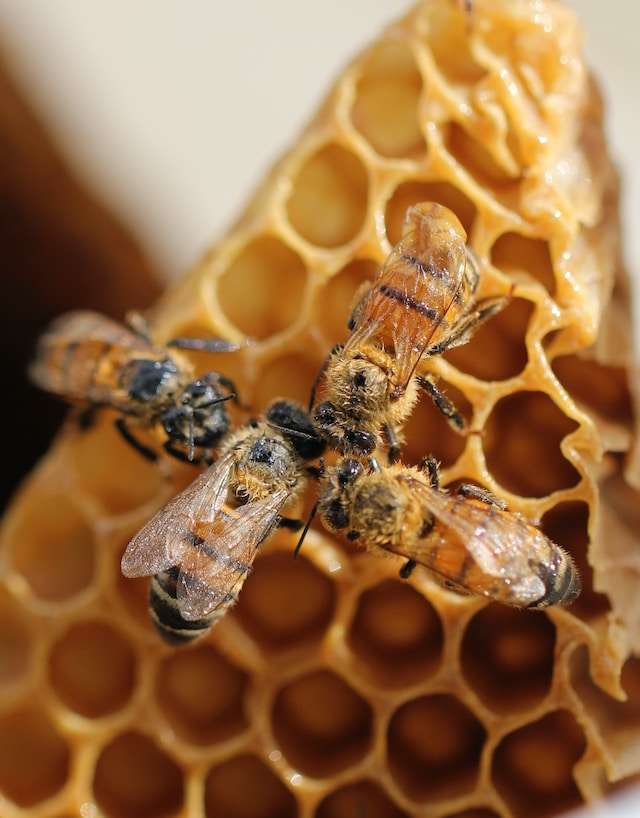
- Honey and Pollen Storage Limitations
One of the key consequences of dearth periods is the limitation it imposes on the storage of honey and pollen within beehives. Bees typically rely on an abundant supply of nectar and pollen to produce honey and store it for future use.
However, during dearth periods, the lack of resources restricts their ability to collect and store sufficient amounts of honey and pollen, jeopardizing their food reserves. This scarcity in stored food can have severe implications, especially during extended periods of dearth.
- Increased Risk of Starvation and Colony Collapse
The scarcity of food resources during dearth periods significantly increases the risk of starvation and colony collapse. Honey bees rely on stored honey reserves to sustain themselves during times of scarcity. However, when the reserves are depleted, the colony’s survival is at stake.
Starvation weakens the bees, making them susceptible to diseases and parasites. Additionally, weakened colonies are less capable of withstanding other environmental challenges, ultimately leading to the collapse of the entire colony.
Identifying Dearth Periods
Identifying dearth periods in beekeeping is crucial for successful beekeeping management. Dearth periods are periods of reduced nectar and pollen availability, which can significantly impact the health and productivity of honeybee colonies.
A. Monitoring Nectar Flow and Foraging Activities
One of the primary ways to identify dearth periods is by closely monitoring the nectar flow and foraging activities of honeybees. Beekeepers can employ the following strategies:
- Monitoring Nectar Sources: Keeping track of the availability and abundance of nectar sources in the vicinity of the hive is essential. This can be done by observing the types and number of flowering plants that bees visit for nectar collection.
- Regular Hive Inspections: Conducting frequent hive inspections allows beekeepers to assess the nectar storage within the hive. Monitoring the amount of capped honey can indicate the availability of nectar in the surrounding area.
- Pollen Collection: Assessing the pollen collection by bees can provide insights into the availability of floral resources. Tracking the colors and amounts of pollen brought into the hive helps beekeepers understand the diversity and abundance of pollen sources.
B. Recognizing Changes in Bee Behavior and Hive Activity
Beekeepers can identify dearth periods by observing changes in bee behavior and hive activity. The following signs can indicate a dearth period:
- Decreased Foraging Activity: Honeybees exhibit reduced foraging activities during dearth periods. Beekeepers should observe the number of bees leaving the hive for foraging trips. A significant drop in foraging activity may indicate a nectar scarcity.
- Aggressive Behavior: Bees can become more defensive and aggressive during dearth periods due to limited resources. Increased incidence of stinging and heightened aggression towards intruders are signs of a dearth period.
- Robbing Behavior: Dearth periods often lead to increased robbing behavior among honeybees. Robbing occurs when weak colonies or colonies lacking resources attempt to steal honey from stronger colonies. Frequent robbing attempts may indicate a shortage of forage.
C. Utilizing Tools and Techniques for Dearth Period Evaluation
To effectively evaluate dearth periods, beekeepers can utilize various tools and techniques:
- Weighing Hives: Weighing hives using specialized hive scales enables beekeepers to monitor changes in hive weight, indicating fluctuations in nectar availability.
- Using a Beekeepers Journal: Maintaining a journal to record hive observations, including nectar flow conditions, changes in bee behavior, and hive inspections, aids in tracking and identifying dearth periods.
- Participating in Beekeeping Communities: Engaging with fellow beekeepers through local clubs, online forums, or social media platforms can provide valuable insights and collective knowledge about regional dearth periods. Learning from experienced beekeepers in the community is a valuable resource for identifying dearth periods.
Mitigating the Impact of Dearth Periods
Enhancing Bee Habitat and Forage Availability
Beekeeping is an intricate practice that requires careful attention to ensure the well-being and productivity of honeybee colonies. There are several strategies that beekeepers can employ to mitigate the impact of dearth periods and support their bee colonies.
A. Providing supplemental feeding options
Supplemental feeding is an essential tool for beekeepers to ensure that their colonies have access to a steady and reliable food source during dearth periods. The following options can be considered:
- Sugar syrup: Beekeepers can prepare a sugar syrup mixture to provide their honeybees with the necessary carbohydrates. A common ratio is one part sugar to one part water, although it may vary depending on specific beekeeping practices and climate conditions.
- Pollen substitute patties: These patties mimic the nutritional content of natural pollen and can serve as an alternative protein source for honeybees during dearth periods. Pre-made or homemade patties can be placed near the colony for easy access.
B. Ensuring access to water sources
Water is vital for honeybees, especially during dearth periods when natural sources become scarce. By providing accessible and clean water, beekeepers can help their colonies stay hydrated and maintain their physiological functions. Consider the following measures:
- Water containers: Set up shallow water containers close to the hive, ensuring easy access for bees. Adding floating objects, such as pieces of wood or rocks, can provide landing spots for bees, preventing accidental drownings.
- Regular maintenance: Maintain the water containers by regularly replacing the water to ensure freshness and cleanliness. Bees are drawn to clean water sources, reducing the risk of disease transmission within the colony.
C. Enhancing bee habitat and forage availability
Creating a conducive environment that supports ample forage availability is key to mitigating the impact of dearth periods. Consider the following methods:
- Planting bee-friendly flowers: Cultivate a diverse range of flowering plants that bloom successively throughout the year. This will provide honeybees with a continuous source of nectar and pollen, reducing the impact of dearth periods.
- Avoiding pesticide use: Pesticides can be harmful to honeybees and other pollinators. Opt for organic and natural pest control methods, promoting the overall health of the bee population and their surrounding habitat.
Strategies for Beekeepers
Adjustments in Hive Management during Dearth Periods
During dearth periods, when nectar and pollen availability is limited, beekeepers need to make certain adjustments in hive management to ensure the health and productivity of their hives.
- Reducing the Hive Space
As nectar becomes scarce, it is vital to reduce the hive space to prevent the bees from wasting energy and resources in maintaining larger areas. By removing excess frames or consolidating brood chambers, beekeepers can help their colonies conserve energy and focus their efforts on essential tasks.
- Monitoring and Controlling Pest Infestations
Dearth periods can create favorable conditions for pests and parasites, such as mites, beetles, or wax moths, to infest the hive. Regular monitoring of hive conditions and implementing effective pest control measures are crucial to minimizing the impact of these invaders.
Beekeepers should closely inspect their colonies for signs of infestation and promptly take appropriate actions to protect the bees.
- Managing Varroa Mite Populations
Varroa mites, one of the most significant threats to honeybee colonies, must be actively managed during dearth periods. These parasites weaken the bees, transmit diseases, and can ultimately decimate entire colonies if left unchecked.
Beekeepers should employ integrated pest management strategies, such as using organic treatments or employing biotechnical methods, to reduce the impact of varroa mites on their hives.
Importance of Beekeeper Education and Awareness
As a beekeeper, it is crucial to continuously learn and stay informed about the latest practices, technologies, and research in order to effectively nurture and protect your bee colonies.
Roles of local beekeeping organizations and associations:
Local beekeeping organizations and associations play a pivotal role in fostering education and awareness among beekeepers. These communities serve as valuable platforms for sharing information, discussing challenges, and exchanging ideas.
By joining a local organization, beekeepers gain access to a network of experienced individuals who are passionate about beekeeping. The benefits of these associations include:
- Networking opportunities: Local beekeeping organizations provide a space for beekeepers to connect, collaborate, and build relationships. Through workshops, seminars, and conferences, beekeepers can meet seasoned professionals, researchers, and fellow enthusiasts who can impart valuable knowledge and share personal experiences.
- Educational programs: These organizations often host educational programs designed to enhance the skills and knowledge of beekeepers. From beginner courses to advanced workshops, beekeepers can enroll in training sessions that cover various topics such as bee biology, hive management techniques, honey extraction, and pest control.
- Resource sharing: Local beekeeping associations act as a hub for sharing resources, such as books, journals, and informational materials. Additionally, they might maintain a library of equipment that beekeepers can borrow or rent, reducing initial investments.
Training programs and resources for beekeepers:
As the world of beekeeping continues to evolve, numerous training programs and resources have emerged to cater to the needs of beekeepers. These initiatives aim to equip individuals with the necessary skills, knowledge, and techniques to nurture healthy bee colonies. Some of the key training programs and resources available for beekeepers include:
- Beekeeping courses: Many educational institutions and agricultural centers offer specialized courses on beekeeping. These courses provide a structured curriculum that covers various aspects, including bee biology, colony management, honey production, and bee health. Enrolling in these courses empowers beekeepers with a solid foundation and improves their overall beekeeping abilities.
- Online resources: With the advent of the internet, beekeepers now have access to a wealth of information at their fingertips. Online platforms offer a plethora of resources, such as websites, forums, videos, and webinars, enabling beekeepers to learn at their own pace and connect with experts from across the globe.
- Mentorship programs: Experienced beekeepers often volunteer to mentor novices, sharing their expertise and guiding them through the fascinating journey of beekeeping. Mentorship programs provide personalized guidance and hands-on training, ensuring that beginners receive the support they need to become successful beekeepers.
Sharing experiences and knowledge within the beekeeping community:
One of the most valuable aspects of the beekeeping community is the practice of sharing experiences and knowledge among its members. This exchange of information fosters growth, stimulates innovation, and helps beekeepers navigate challenges effectively. The benefits of sharing within the beekeeping community include:
- Problem-solving: Beekeepers encounter various challenges, such as diseases, pests, or environmental factors that impact their colonies. By sharing experiences and discussing these issues within the community, beekeepers can collectively brainstorm solutions, offering different perspectives and insights.
- Best practices: The beekeeping community is constantly evolving, with new techniques and best practices emerging regularly. By staying connected with other beekeepers, individuals can learn about innovative methods, equipment, or approaches that can enhance the productivity and well-being of their bees.
- Research collaboration: Collaboration within the beekeeping community brings together researchers, scientists, and beekeepers to address key issues and conduct studies. This interdisciplinary collaboration contributes to a better understanding of bees, their habitats, and potential threats they face, driving the advancement of sustainable practices.
Conclusion
Dearth periods are an important natural balance for a bee population, but they can also wreak havoc if they are not managed correctly. Fortunately, there are a few key management techniques that a beekeeper can employ to reduce the impact of a dearth period and provide assistance to their hive.
By monitoring the hive closely and providing a variety of supplemental feeds, insulating and ventilating the hive adequately, and varying sources of nutrition, a beekeeper can ensure their colony remains healthy and strong, even during difficult times.
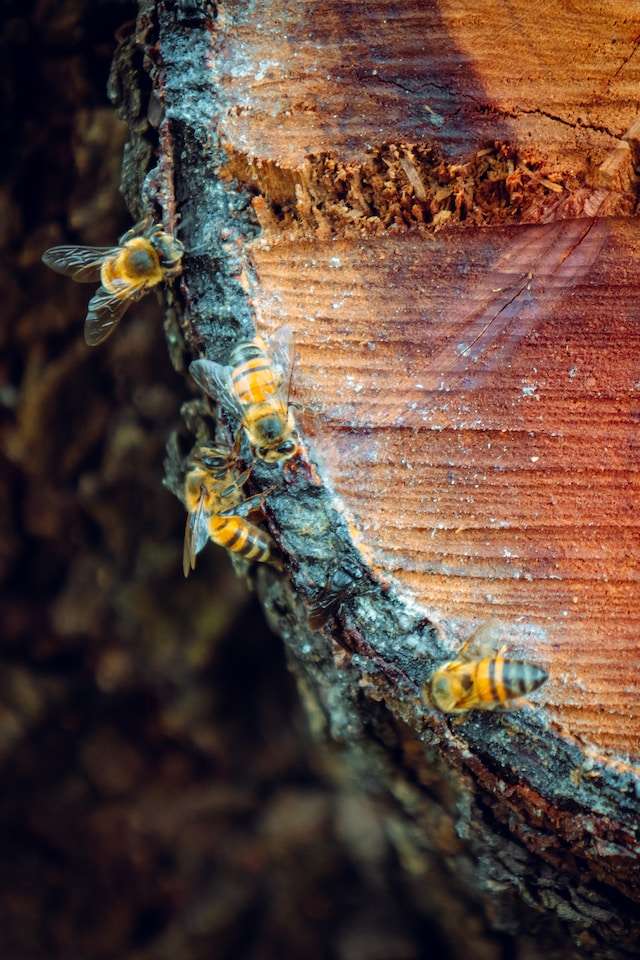
Frequently Asked Questions
How long does a dearth period typically last?
- The duration of a dearth period can vary depending on factors such as geographical location, weather conditions, and local flora. In some regions, dearths may last for a few weeks, while in others, they can persist for several months. It primarily depends on the availability of flowering plants and the natural forage during that specific time.
How does a dearth period affect honeybee colonies?
- During a dearth period, honeybee colonies experience a decrease in available food sources. This scarcity can lead to reduced brood rearing, a decrease in honey production, and potential weight loss for the colony. To counter the lack of food, bees might become more aggressive and exhibit increased robbinog behavior as they search for alternative sources of sustenance.
How can beekeepers identify a dearth period?
- Beekeepers can observe signs of a dearth period by monitoring the foraging activity of their honeybee colonies. Reduced or almost nonexistent activity around hive entrances during peak foraging hours, fewer bees returning with full pollen baskets, and a general decline in visible foraging are indications of a dearth. Checking honey stores or observing decreased brood production can also suggest a possible dearth.
Are all regions susceptible to dearth periods?
- Dearth periods can affect beekeeping regions differently, as they are influenced by local flora, climate, and geographic factors. While some regions may experience minimal dearths due to a consistent availability of blooms and forage, many regions observe distinct dearth periods during specific times of the year. Understanding the local beekeeping calendar can help beekeepers anticipate and prepare for dearth periods.
Should I feed bees during dearth?
- Use an internal or enclosed hive-top feeder and avoid drips and spills. If you have a strong nectar flow in autumn, feeding bees during the summer dearth has advantages. Normally, the hive population drops during a dearth because when nectar stops coming in, the queen restricts her egg laying.
What impact can dearth periods have on honey production?
- Dearth periods often result in reduced honey production due to the limited availability of nectar during that time. As honeybees struggle to find sufficient food sources, they utilize stored honey reserves to sustain the colony. Consequently, honey production may decrease, or in severe dearths, honey surplus can be entirely absent.
How can beekeepers help honeybee colonies survive a dearth period?
- Beekeepers can support honeybee colonies during dearth periods by providing supplementary feeding options. This can include offering sugar syrup or pollen substitutes that emulate natural forage. Ensuring the availability of clean water near the hives is also important. Additionally, managing hive health, minimizing stress factors, and maintaining strong colonies before the dearth can increase their chances of survival.
Are there any benefits to dearth periods in beekeeping?
- While dearth periods can pose challenges for honeybee colonies and beekeepers, they also play a role in the natural cycle. Dearth periods help regulate the availability and distribution of resources, fostering a balanced ecosystem for both honeybees and other pollinators. Additionally, dearths can prompt beekeepers to implement strategies that enhance hive management skills, foster resource conservation, and improve overall environmental awareness.
